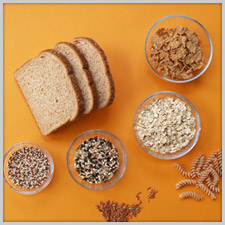Heart & Stroke Health Check™ nutrient standards for fibre
Heart&Stroke Health Check™ is a food information program with nutrient standards based on Canada's Food Guide. The Health Check symbol can help you choose foods in grocery stores and restaurants that can be part of a healthy diet. Each food product and restaurant dish in the Health Check program is evaluated by the Heart and Stroke Foundation's registered dietitians on the basis of fat, sodium, fibre and sugar as well as protein, vitamins and minerals, depending on the item. All participating food manufacturers and restaurateurs must meet these nutrient standards in order to display the Heart&Stroke Health Check symbol. Here are the nutrient standards for fibre.
Fibre
Nutrition experts would like to see all of us bulk up – and they're not just talking about our muscles. No, they're talking about fibre. According to Carol Dombrow, the Heart and Stroke Foundation's registered dietitian for Health Check, Canadians consume only about half of the fibre they require each day – only about 15 grams of the recommended 21 to 38 grams. That may be because Canadians are not having the required 5 to 10 vegetables and fruit a day and eating too many refined foods made with white flour – a wheat flour that has been stripped of most of its fibre.

Whole grains include quinoa, wild rice, oats, bran flakes, whole-grain brown rice, spelt, whole-wheat pasta and bread
There's good reason to make fibre your friend. A carbohydrate found in plants and whole grains, fibre passes through the body undigested so it increases that feeling of fullness, without adding calories – and that's a good thing if you're trying to maintain a healthy weight.
Fibre can be divided into two major types: soluble and insoluble. Soluble is softer and, apart from helping you feel full, it helps lower cholesterol and control blood sugar. Soluble fibre-rich foods include oatmeal and oat bran, legumes, beans, nuts, peas, lentils and fruits.
Insoluble fibre, called roughage, promotes regularity because it helps move food through the bowel quickly and efficiently. You can find insoluble fibre in wheat bran, whole grain foods such as whole-wheat or multigrain bread, whole-wheat pasta, brown rice, and the leaves, skins and seeds of vegetables and fruits.
Heart&Stroke Health Check nutrient standards for fibre
Whenever possible, look for food products that use the whole grain. Food items such as cereals, breads, pastas, rice and other grain products with the Heart&Stroke Health Check symbol must have at least 2 grams of fibre or more.
| Food Product | Health Check criteria for fibre |
|---|---|
| Source of fibre | 2 grams |
| High source of fibre | 4 grams |
| Very high source of fibre | 6 grams or more |

